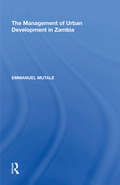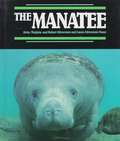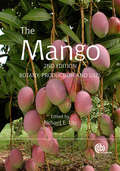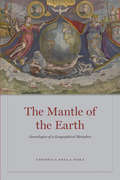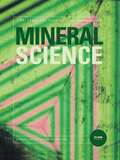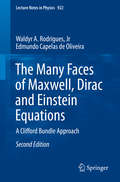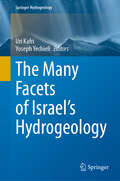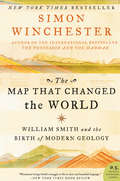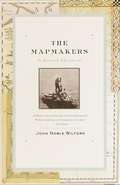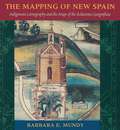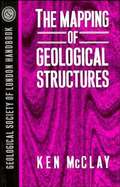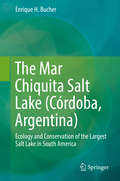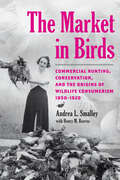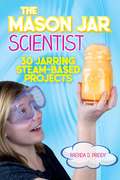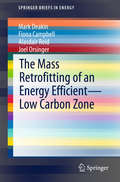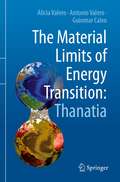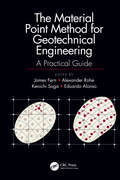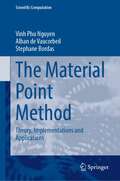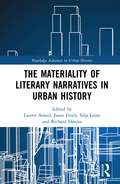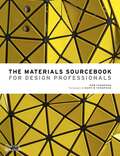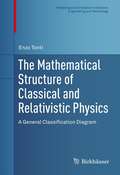- Table View
- List View
The Management of Urban Development in Zambia (International Land Management Ser.)
by Emmanuel MutaleOver the past few decades, the developing world has seen unprecendented urban growth and urban areas have had to deal with a number of complex problems as a result. While population growth is one of the factors contributing to the deprivation and decay characteristic of most urban areas in the developing world, there are other factors. Apart from demographic and economic factors, the political organization factor of centralization has concentrated decision-making and with it resources in the urban areas, leading to further rural-urban migration. Another factor is one of colonialism. The transfer of foreign social structures and technology, while offering alternatives, has dislocated and significantly altered indigenous patterns of development in the developing world. This book examines a region where this last factor is a major significance; Zambia's copperbelt. Here, the concentration of towns which were developed very rapidly in the 1930s made Zambia one of the most highly urbanized Sub-Saharan countries. By focusing on copperbelt towns, the book provides a critical analysis of the development of urban policy in Zambia. Aspects of conflict and cooperation between different interest groups and - where relevant - their economic relationships are explored and a structural conflict model of urban management is proposed. The book concludes that, with proper management, existing and emerging sectional interests in urban areas can help provide conditions which foster the formulation of equitable urban policy. Although focused on Zambia, the proposed structural conflict approach has potential for wider application.
The Manatee (Endangered in America)
by Alvin Silverstein Virginia Silverstein Robert Silverstein Laura Silverstein NunnFrom the Book Jacket: ENDANGERED IN AMERICA More than 300 kinds of North American anil endangered or threatened - at risk of dyini are taking action to help them, sometimes success. These books present the stories oi animals, and of the efforts to save thei The Spotted Owl The Red Wolf The Black-Footed Ferret The Peregrine Falcon The Sea Otter The Manatee Other books in this series are available from Bookshare.
The Mango: Botany, Production and Uses (2nd edition)
by Richard E. LitzThe first comprehensive scientific reference in 30 years on the fruit that has been cultivated in India for at least four thousand years, is the most important fruit crop of Asia and one of the most important worldwide, and the production of which has multiplied over the past decade to serve the increasing popularity in Europe in North America. Specialists from many of the new regions in which mango are now being cultivated discuss such aspects as taxonomy and systematics, classical breeding and genetics, reproductive physiology, stress physiology, mineral nutrition, diseases, insect pests, biotechnology, postharvest physiology, processing, and important cultivars and their descriptors. Annotation c. by Book News, Inc., Portland, OR.
The Mangrove Tree: Planting Trees to Feed Families
by Susan L. Roth Cindy TrumboreThe fascinating story of Dr. Gordon Sato, who helped a small African village become self-sustaining by planting a forest of mangrove trees to reshape the community's ecosystem.For a long time, the people of Hargigo, a village in the tiny African country of Eritrea, were living without enough food for themselves and their animals. The families were hungry, and their goats and sheep were hungry too. Then along came a scientist, Dr. Gordon Sato, who helped change their lives for the better. And it all started with some special trees. These are the trees, Mangrove trees, That were planted by the sea. With alternating verse and prose passages, The Mangrove Tree invites readers to discover how Dr. Sato's mangrove tree-planting project transformed an impoverished village into a self-sufficient community. This fascinating story is a celebration of creativity, hard work-and all those mangrove trees that were planted by the sea!
The Mantle of the Earth: Genealogies of a Geographical Metaphor
by Veronica della DoraThe term mantle has inspired philosophers, geographers, and theologians and shaped artists’ and mapmakers’ visual vocabularies for thousands of years. According to Veronica della Dora, mantle is the “metaphor par excellence, for it unfolds between the seen and the unseen as a threshold and as a point of tension.” Featuring numerous illustrations, The Mantle of the Earth: Genealogies of a Geographical Metaphor is an intellectual history of the term mantle and its metaphorical representation in art and literature, geography and cartography. Through the history of this metaphor from antiquity to the modern day, we learn about shifting perceptions and representations of global space, about our planetary condition, and about the nature of geography itself.
The Mantle of the Earth: Genealogies of a Geographical Metaphor
by Veronica della DoraThe term mantle has inspired philosophers, geographers, and theologians and shaped artists’ and mapmakers’ visual vocabularies for thousands of years. According to Veronica della Dora, mantle is the “metaphor par excellence, for it unfolds between the seen and the unseen as a threshold and as a point of tension.” Featuring numerous illustrations, The Mantle of the Earth: Genealogies of a Geographical Metaphor is an intellectual history of the term mantle and its metaphorical representation in art and literature, geography and cartography. Through the history of this metaphor from antiquity to the modern day, we learn about shifting perceptions and representations of global space, about our planetary condition, and about the nature of geography itself.
The Manual of Mineral Science (23rd Edition)
by Cornelis Klein Barbara DutrowThe book offers readers coverage of mineralogy and crystallography, integrating complete coverage of concepts and principles with a more systematic and descriptive treatment of mineralogy.
The Many Faces of Maxwell, Dirac and Einstein Equations
by Jr Waldyr A. Rodrigues Edmundo Capelas de OliveiraThis book is an exposition of the algebra and calculus of differentialforms, of the Clifford and Spin-Clifford bundle formalisms, and of vistas to aformulation of important concepts of differential geometry indispensable for anin-depth understanding of space-time physics. The formalism discloses the hidden geometrical nature of spinor fields. Maxwell, Dirac and Einstein fields are shown to have representatives by objectsof the same mathematical nature, namely sections of an appropriate Cliffordbundle. This approach reveals unity in diversity and suggests relationshipsthat are hidden in the standard formalisms and opens new paths for research. This thoroughly revised second edition also adds three new chapters: on the Cliffordbundle approach to the Riemannian or semi-Riemannian differential geometry ofbranes; on Komar currents in the context of the General Relativity theory; andan analysis of the similarities and main differences between Dirac, Majoranaand ELKO spinor fields. The exercises with solutions, thecomprehensive list of mathematical symbols, and the list of acronyms andabbreviations are provided for self-study for students as well as for classes. From the reviews of the firstedition: "The text is written in a veryreadable manner and is complemented with plenty of worked-out exercises whichare in the style of extended examples. . . . their book could also serve as atextbook for graduate students in physics or mathematics. " (AlbertoMolgado, Mathematical Reviews, 2008 k)
The Many Facets of Israel's Hydrogeology (Springer Hydrogeology)
by Uri Kafri Yoseph YechieliThis book presents a collection of essays that address various facets of the hydrogeology of Israel. Despite its small geographic size, Israel exhibits a variety of climates and is located between two regional fluctuating base levels. The respective chapters discuss the variety of hydrogeological configurations and hydrological processes produced by these geographical circumstances. In some cases, the interpretation of these aspects is deliberately left open to debate, because the authors were asked to provide, in addition to their own views, also alternative and even conflicting ones. Hydrogeological configurations similar to those in Israel can be found in other countries around the world. Therefore, researchers, scholars and professionals in this interdisciplinary field can benefit from and directly apply the considerable experience and expertise that has been gathered in Israel over the past few decades.
The Map That Changed the World
by Simon WinchesterIn 1793, a canal digger named William Smith made a startling discovery. He found that by tracing the placement of fossils, which he uncovered in his excavations, one could follow layers of rocks as they dipped and rose and fell--clear across England and, indeed, clear across the world--making it possible, for the first time ever, to draw a chart of the hidden underside of the earth. Smith spent twenty-two years piecing together the fragments of this unseen universe to create an epochal and remarkably beautiful hand-painted map. But instead of receiving accolades and honors, he ended up in debtors' prison, the victim of plagiarism, and virtually homeless for ten years more. The Map That Changed the World is a very human tale of endurance and achievement, of one man's dedication in the face of ruin. With a keen eye and thoughtful detail, Simon Winchester unfolds the poignant sacrifice behind this world-changing discovery.
The Map That Changed the World
by Simon WinchesterIn 1793, a canal digger named William Smith made a startling discovery. He found that by tracing the placement of fossils, which he uncovered in his excavations, one could follow layers of rocks as they dipped and rose and fell--clear across England and, indeed, clear across the world--making it possible, for the first time ever, to draw a chart of the hidden underside of the earth. Smith spent twenty-two years piecing together the fragments of this unseen universe to create an epochal and remarkably beautiful hand-painted map. But instead of receiving accolades and honors, he ended up in debtors' prison, the victim of plagiarism, and virtually homeless for ten years more. The Map That Changed the World is a very human tale of endurance and achievement, of one man's dedication in the face of ruin. With a keen eye and thoughtful detail, Simon Winchester unfolds the poignant sacrifice behind this world-changing discovery.
The Mapmakers (Revised Edition)
by John Noble WilfordIn his classic text, two-time Pulitzer Prize-winner John Noble Wilford recounts the history of cartography from antiquity to the space age. They are among the world's great pioneers and adventurers: the mapmakers who for centuries have been expanding our knowledge of who and where we are, and where we want to go. From the surprisingly accurate silk maps prepared by Chinese cartographers in the second century B. C. , to medieval mapmakers who believed they had fixed the location of paradise, through to the expeditions of Columbus and Magellan, John Noble Wilford chronicles the exploits of the great pioneers of mapmaking. Wilford brings the story up to the present day as he shows the impact of new technologies that make it possible for cartographers to go where no one has been before, from the deepest reaches of the universe (where astronomers are mapping time as well as space) to the inside of the human brain. These modern-day mapmakers join the many earlier adventurers--including ancient Greek stargazers, Renaissance seafarers, and the explorers who mapped the American West--whose achievements shape this dramatic story of human inventiveness and limitless curiosity.
The Mapping Of New Spain: Indigenous Cartography And The Maps Of The Relaciones Geograficas
by Barbara E. MundyTo learn about its territories in the New World, Spain commissioned a survey of Spanish officials in Mexico between 1578 and 1584, asking for local maps as well as descriptions of local resources, history, and geography. In The Mapping of New Spain, Barbara Mundy illuminates both the Amerindian (Aztec, Mixtec, and Zapotec) and the Spanish traditions represented in these maps and traces the reshaping of indigene world views in the wake of colonization.
The Mapping of Geological Structures
by K. R. McclayDetailed mapping and analysis of the structural features of rocks enable the 3D geometry of their structures to be reconstructed. The resulting evidence of the stresses and movement patterns which rocks have undergone indicates the processes by which they were formed, and allows evaluation of past deformations of the earth's crust. Written to show how one actually describes, measures and records rock structures such as folds and faults with the emphasis on accuracy, detail and on-going interpretation throughout, this handbook gives students and enthusiasts the practical information and guidance which allows their fieldwork to become vastly more rewarding."...the author is to be congratulated on producing such an excellent text. The whole range of mapping techniques that an undergraduate student will require are described and the book will still be immense help to post-graduates setting out on their research work. The book represents extremely good value and is thoroughly recommended."--C.R.L. Friend, Mineralogical Magazine
The Mapping of Power in Renaissance Italy
by Mark RosenHow did maps of the distant reaches of the world communicate to the public in an era when exploration of those territories was still ongoing and knowledge about them remained incomplete? And why did Renaissance rulers frequently commission large-scale painted maps of those territories when they knew that they would soon be proven obsolete by newer, more accurate information? The Mapping of Power in Renaissance Italy addresses these questions by bridging the disciplines of art history and the histories of science, cartography, and geography to closely examine surviving Italian painted maps that were commissioned during a period better known for its printed maps and atlases. Challenging the belief that maps are strictly neutral or technical markers of geographic progress, this well-illustrated study investigates the symbolic and propagandistic dimensions of these painted maps as products of the competitive and ambitious European court culture that produced them.
The Mar Chiquita Salt Lake (Córdoba, Argentina): Ecology and Conservation of the Largest Salt Lake in South America
by Enrique H. BucherThis book provides a comprehensive, updated syntheses of all the information available on Mar Chiquita, covering various aspects of the geography, geological history, biology and ecology of the site, as well as a detailed analysis of the current land-use patterns, environmental threats, and conservation issues. Mar Chiquita, located in the province of Cordoba, Argentina, is a protected wilderness area that includes South America’s largest saline lake and wetland. It has a very rich bird biodiversity, including three of the six species of flamingos that exist in the world, and high numbers of intercontinental migratory shorebirds. For this reason, the area has been declared an International Site by the Ramsar Convention on Wetlands of International Importance, and also a Site of Hemispheric Importance by the Western Hemisphere Shorebird Reserves Network. Largely unknown until very recently, particularly in terms of the English literature, the site is rapidly gaining international visibility, not only in terms of scientific research, but also as site of interest for the nature lovers around the globe. Written in a language accessible to the non-specialists, the book focuses on integrating the dynamic, functional processes in the ecosystem, while at the same time providing the necessary descriptive information. Accordingly, it is of interest to scientists from diverse disciplines interested in saline wetlands, as well as to students, managers, and the general public.
The Market in Birds: Commercial Hunting, Conservation, and the Origins of Wildlife Consumerism, 1850–1920
by Andrea L. SmalleyA fascinating look at how a commercial market for birds in the late nineteenth century set the stage for conservation and its legislation.Between the end of the Civil War and the 1920s, the United States witnessed the creation, rapid expansion, and then disappearance of a commercial market for hunted wild animals. The bulk of commercial wildlife sales in the last part of the nineteenth century were of wildfowl, who were prized not only for their eggs and meat but also for their beautiful feathers. Wild birds were brought to cities in those years to be sold as food for customers' tables, decorations for ladies' hats, treasured pets, and specimens for collectors' cabinets. Though relatively short-lived, this market in birds was broadly influential, its rise and fall coinciding with the birth of the Progressive Era conservation movement. In The Market in Birds, historian Andrea L. Smalley and wildlife biologist Henry M. Reeves illuminate this crucial chapter in American environmental history. Touching on ecology, economics, law, and culture, the authors reveal how commercial hunting set the terms for wildlife conservation and the first federal wildlife legislation at the turn of the twentieth century. Smalley and Reeves delve into the ground-level interactions among market hunters, game dealers, consumers, sportsmen, conservationists, and the wild birds they all wanted. Ultimately, they argue, wildfowl commercialization represented a revolutionary shift in wildlife use, turning what had been a mostly limited, local, and seasonal trade into an interstate industrial-capitalist enterprise. In the process, it provoked a critical public debate over the value of wildlife in a modern consumer culture. By the turn of the twentieth century, the authors reveal, it was clear that wild bird populations were declining precipitously all over North America. The looming possibility of a future without birds sparked intense debate nationwide and eventually culminated in the 1918 Migratory Bird Treaty Act. Scholars, environmentalists, wildlife professionals, and anyone concerned about wildlife will find this new perspective on conservation history enlightening reading.
The Mason Jar Scientist: 30 Jarring STEAM-Based Projects
by Brenda PriddyFun, STEAM-based experiments and activities to do at home—all within a mason jar! Scientific learning doesn't have to stop when kids hop off the school bus. With The Mason Jar Scientist, you and your kids can have a blast together while learning about fascinating scientific topics! This book provides dozens of practical, hands-on experiments illustrating scientific principles—that can all be done within a mason jar. Each experiment also includes discussion questions and great ideas for STEAM-based extension activities. You and your child will learn about: Clouds Why the sky is blue Tornadoes The greenhouse effect Light refraction Sound vibrations The solar system Biomes And much more! All you need for each activity is a mason jar, some household ingredients, and a desire to learn! Packed with colorful photos, clear, information, and easy-to-follow instructions, The Mason Jar Scientist is the perfect book to get kids excited about science and to spend some quality time together.
The Mass Retrofitting of an Energy Efficient--Low Carbon Zone
by Mark Deakin Fiona Campbell Alasdair Reid Joel OrsingerMaximizing reader insights into the strategic value of mass retrofits in the residential property sector through a detailed case study analysis of the 'Hackbridge project', this book uses this development to broaden understanding of how planners may perform urban regeneration in accordance with a centralized plan. This book demonstrates how urban morphology matters, not only with respect to either the geometry of design and construction systems, or occupational behaviours, but with regards to the potential with which the planning, (re)development, design, construction, use and occupation of buildings, has to not only lower levels of energy consumption and rates of carbon emission, but also to reduce global warming associated with climate change. Delivering a critique of the state-of-the-art on urban morphology, the geometry of design typologies, construction systems and occupational behaviours and armed with the critical insights this offers, this book offers a context-specific analysis of how institutions can begin to actively plan for, integrate and sustain the development of energy efficient-low carbon zones.
The Material Limits of Energy Transition: Thanatia
by Antonio Valero Alicia Valero Guiomar CalvoEarth has become a huge mine, with a greater quantity and variety of fundamental mineral resources being extracted year after year. Technology, from electric cars to everyday electrical equipment, consume vast amounts of scarce raw materials. On a planet with limited resources, are these minerals being properly assessed? Will there be enough raw materials to meet the demand of a world population on track to reach 10 billion people? What will be the consequences of accelerated resource depredation? Will the planet one day become 'Thanatia', a resource-exhausted Earth?This book allows readers to understand the mineral heritage of the Earth, considering the demand for raw materials in society, comparing it with the availability of resources on Earth and the impact of mining. The basics of physical geonomics are exlpained, allowing readers to analyse the loss of mineral resources on the planet. The impact of renewable energies and technologies, including electric vehicles, are studied. The book concludes with possible solutions to mineral depletion, from increasing recycling rates, ecodesign measures or alternative sources of mineral resources. Providing numerous tables and illustrations, 'The Material Limits of Energy Transition: Thanatia' gives readers a thorough understanding of mineral depletion. Exploring geology, geochemistry, mining, metallurgy, the environment and thermodynamics, this is a truly holistic book.
The Material Point Method for Geotechnical Engineering: A Practical Guide
by James Fern Alexander Rohe Kenichi Soga Eduardo AlonsoThis practical guide provides the best introduction to large deformation material point method (MPM) simulations for geotechnical engineering. It provides the basic theory, discusses the different numerical features used in large deformation simulations, and presents a number of applications -- providing references, examples and guidance when using MPM for practical applications. <P><P>MPM covers problems in static and dynamic situations within a common framework. It also opens new frontiers in geotechnical modelling and numerical analysis. It represents a powerful tool for exploring large deformation behaviours of soils, structures and fluids, and their interactions, such as internal and external erosion, and post-liquefaction analysis; for instance the post-failure liquid-like behaviours of landslides, penetration problems such as CPT and pile installation, and scouring problems related to underwater pipelines. In the recent years, MPM has developed enough for its practical use in industry, apart from the increasing interest in the academic world.
The Material Point Method: Theory, Implementations and Applications (Scientific Computation)
by Vinh Phu Nguyen Alban de Vaucorbeil Stephane BordasThis book provides an introduction to the fundamental theory, practical implementation, and core and emerging applications of the material point method (MPM) and its variants. The MPM combines the advantages of both finite element analysis (FEM) and meshless/meshfree methods (MMs) by representing the material by a set of particles overlaid on a background mesh that serves as a computational scratchpad.The book shows how MPM allows a robust, accurate, and efficient simulation of a wide variety of material behaviors without requiring overly complex implementations. MPM and its variants have been shown to be successful in simulating a large number of high deformation and complicated engineering problems such as densification of foam, sea ice dynamics, landslides, and energetic device explosions, to name a few, and have recently found applications in the movie industry. It is hoped that this comprehensive exposition on MPM variants and their applications will not only provide an opportunity to re-examine previous contributions, but also to re-organize them in a coherent fashion and in anticipation of new advances.Sample algorithms for the solutions of benchmark problems are provided online so that researchers and graduate students can modify these algorithms and develop their own solution algorithms for specific problems. The goal of this book is to provide students and researchers with a theoretical and practical knowledge of the material point method to analyze engineering problems, and it may help initiate and promote further in-depth studies on the subjects discussed.
The Materiality of Literary Narratives in Urban History (Routledge Advances in Urban History)
by Richard Dennis Lieven Ameel Jason Finch Silja LaineThe Materiality of Literary Narratives in Urban History explores a variety of geographical and cultural contexts to examine what literary texts, grasped as material objects and reflections on urban materialities, have to offer for urban history. The contributing writers’ approach to literary narratives and materialities in urban history is summarised within the conceptualisation ‘materiality in/of literature’: the way in which literary narratives at once refer to the material world and actively partake in the material construction of the world. This book takes a geographically multipolar and multidisciplinary approach to discuss cities in the UK, the US, India, South Africa, Finland, and France whilst examining a wide range of textual genres from the novel to cartoons, advertising copy, architecture and urban planning, and archaeological writing. In the process, attention is drawn to narrative complexities embedded within literary fiction and to the dialogue between narratives and historical change. The Materiality of Literary Narratives in Urban History has three areas of focus: literary fiction as form of urban materiality, literary narratives as social investigations of the material city, and the narrating of silenced material lives as witnessed in various narrative sources.
The Materials Sourcebook For Design Professionals
by Rob ThompsonAn indispensable reference for design professionals on selecting and using materials in new ways to make their designs ever more efficient and effective. Today’s technological advancements have resulted in traditional materials being used in increasingly innovative ways; designers are able to push the materials they use to their limits. Understanding these materials helps designers make inspired, practical decisions with confidence. The Materials Sourcebook for Design Professionals provides comprehensive, accurate information about the basic materials with which designers work on a daily basis, as well as a complete breakdown of new and exciting developments in high-tech materials. This inspiring and useful book is organized into six main sections on all the major design material groups: Metal, Plastic, Wood, Plant, Animal, and Mineral. Each section is broken down into chapters examining individual types of material within each larger group. Nearly one hundred material types are featured, each one supported by examples of how it can be used in a variety of industries, an outline of its most desirable properties, and details about its form and texture.
The Mathematical Structure of Classical and Relativistic Physics: A General Classification Diagram
by Enzo TontiThe theories describing seemingly unrelated areas of physics have surprising analogies that have aroused the curiosity of scientists and motivated efforts to identify reasons for their existence. Comparative study of physical theories has revealed the presence of a common topological and geometric structure. The Mathematical Structure of Classical and Relativistic Physics is the first book to analyze this structure in depth, thereby exposing the relationship between (a) global physical variables and (b) space and time elements such as points, lines, surfaces, instants, and intervals. Combining this relationship with the inner and outer orientation of space and time allows one to construct a classification diagram for variables, equations, and other theoretical characteristics. The book is divided into three parts. The first introduces the framework for the above-mentioned classification, methodically developing a geometric and topological formulation applicable to all physical laws and properties; the second applies this formulation to a detailed study of particle dynamics, electromagnetism, deformable solids, fluid dynamics, heat conduction, and gravitation. The third part further analyses the general structure of the classification diagram for variables and equations of physical theories. Suitable for a diverse audience of physicists, engineers, and mathematicians, The Mathematical Structure of Classical and Relativistic Physics offers a valuable resource for studying the physical world. Written at a level accessible to graduate and advanced undergraduate students in mathematical physics, the book can be used as a research monograph across various areas of physics, engineering and mathematics, and as a supplemental text for a broad range of upper-level scientific coursework.
